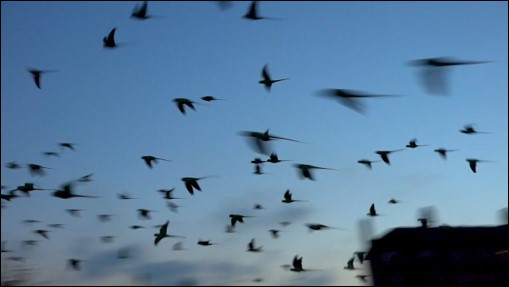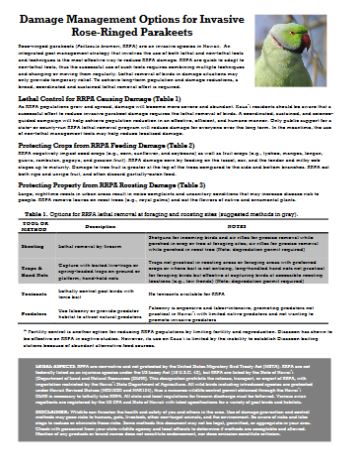
Rose-ringed Parakeet
Rose-ringed Parakeet
Species: Psittacula krameri

Description
- The rose-ring parakeet (RRP) is a long-lived green parakeet native to the Indian subcontinent.
- The average size is about 16 inches, including long tail feathers.
- Males have a red or black neck ring.
Impacts
- RRP are a significant agricultural pest and cause damage to valuable food crops, especially fruits and grains.
- They can also affect wildlife by transporting invasive seeds, displacing cavity nesters, and potentially spreading disease.
- Their mass roosting behavior, loud calls, and accumulated droppings cause disturbance to humans and are a potential public health risk.

On Kauai
On Kauai, RRP have successfully invaded farm lands as well as residential and natural areas. The birds have been observed consuming fruit including longan, lychee, mango, orange, Pritchardia, and corn seeds, causing significant crop losses. First introduced to the island in the 1960’s, RRP took several decades to enter into exponential growth, in 2021 the population was estimated to number around 12,500 birds.

Response
The Kauai community and visitors can help track and gather data on Rose-Ringed Parakeets on Kauai.
The citizen science mapping tool, sponsored by the Kauai Office of Economic Development, aims to monitor bird sightings island-wide. The sighting data collected will assist invasive species specialists, wildlife biologists, farmers, and decision makers to better understand the presence of Rose-Ringed Parakeets on Kauai, develop a population management action plan, and seek necessary funding to implement identified management strategies.
Previous projects led by partners within the Kauai Rose-Ringed Parakeet Working Group included studies to understand the demographics and behavior of the rose-ringed parakeets, the development of a set of interim guidelines for stakeholders, pilot field trials to evaluate control tools, periodic culling operations, and the development of recommendations for a population-level parakeet control management plan. Partner reports and publications are available below.
Pest Alerts and Publications

Biology and Impacts of Pacific Island Invasive Species. 15. Psittacula krameri, the Rose-Ringed Parakeet. Pacific Science (2019) 73:4, 421-449. This is a new scientific publication detailing RRP biology, impacts, and management to date of RRP in the Pacific.

Critical review of potential control tools for reducing damage by the invasive Rose-ringed Parakeet (Psittacula krameri) on the Hawaiian Islands. (52 pages).

USDA-APHIS-WS NWRC Wildlife Damage Manage. This is a condensed version of the Critical review of potential control tools (16 pages).

Damage Management Options Fact Sheet. An interim summary of options for stakeholders (2 pages).

RRP Kauai FAQ sheet updated March, 2020. Answers to Frequently Asked Questions (2 pages)
The Kauai RRP Working Group:
RRP response efforts on Kauai are being coordinated by a multi-agency working group comprised of federal, state, and local government, non-profit and private partners. Members include:
- US Department of Agriculture, Animal and Plant Health Inspection Service, Wildlife Services (USDA-APHIS-WS) in Lihue, HI
- USDA-APHIS-WS National Wildlife Research Center (NWRC) in Hilo, HI; Fargo, ND; Fort Collins, CO; and Gainesville, FL
- Hawaii State Department of Land & Natural Resources, Division of Forestry & Wildlife
- Hawaii State Department of Agriculture
- Hawaii State Department of Health
- County of Kauai, Office of Economic Development
- University of Hawaii, College of Tropical Agriculture & Human Resources
- Hawaii Invasive Species Council
- Kauai Invasive Species Committee
- Kauai County Farm Bureau
- Kauai Landscape Industry Council
